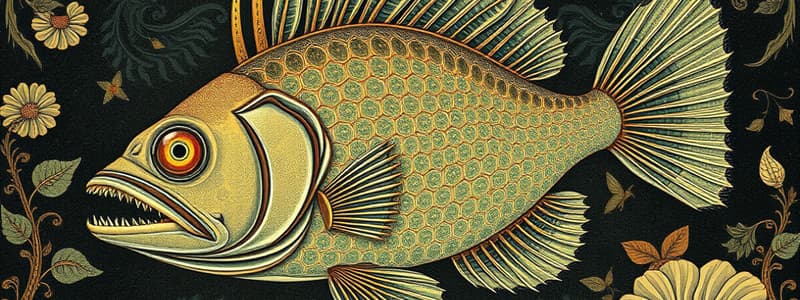Podcast
Questions and Answers
What are gnathostomes?
What are gnathostomes?
Jawed fishes.
What are the derived characteristics of gnathostomes? (Select all that apply)
What are the derived characteristics of gnathostomes? (Select all that apply)
- Lateral line system (correct)
- Feeding without teeth
- Hox duplication (correct)
- Jaw (correct)
How did the development of jaws help gnathostomes?
How did the development of jaws help gnathostomes?
Provided a clamping motion for food, allowed for a broader diet range.
What does more hox duplication mean for an organism?
What does more hox duplication mean for an organism?
What does genome duplication allow for in organisms?
What does genome duplication allow for in organisms?
What is gene duplication?
What is gene duplication?
What happens during nonfunctionalization of duplicated genes?
What happens during nonfunctionalization of duplicated genes?
What is neofunctionalization in gene duplication?
What is neofunctionalization in gene duplication?
What is subfunctionalization?
What is subfunctionalization?
What is the lateral line system?
What is the lateral line system?
Why did early gnathostome fossils outnumber jawless vertebrates?
Why did early gnathostome fossils outnumber jawless vertebrates?
What characterized Dunkleosteus?
What characterized Dunkleosteus?
What are acanthodians also known as?
What are acanthodians also known as?
What are the derived characteristics of chondrichthyans?
What are the derived characteristics of chondrichthyans?
How do chondrichthyans respire without lungs or a swim bladder?
How do chondrichthyans respire without lungs or a swim bladder?
What are the copulatory organs of chondrichthyans?
What are the copulatory organs of chondrichthyans?
What is the diversity and ecology of chondrichthyans?
What is the diversity and ecology of chondrichthyans?
What distinguishes elasmobranchii?
What distinguishes elasmobranchii?
What are holocephali?
What are holocephali?
What are osteichthyans?
What are osteichthyans?
What are the derived characteristics of osteichthyans?
What are the derived characteristics of osteichthyans?
Flashcards are hidden until you start studying
Study Notes
Gnathostomes Overview
- Gnathostomes are jawed fishes, characterized by the development of jaws aiding in a broader diet.
- Key derived characteristics include a jaw, four sets of Hox genes due to duplication, complete genome duplication, and the lateral line system.
Evolutionary Significance of Jaws
- Jaws evolved from anterior rods of gill slits, providing a clamping action for feeding.
- Allows grasping, shearing, and chewing, enhancing dietary options.
Genetic Adaptations and Duplications
- Hox gene duplication allows for greater morphological complexity in organisms.
- Genome duplication enables advanced functions and capabilities in species.
- Gene duplication occurs through random mutation during meiosis, increasing mutation rates. Beneficial mutations can be passed on, leading to new functions or losses of function (nonfunctionalization).
Types of Duplicated Genes
- Nonfunctionalization: one duplicated gene loses its function.
- Neofunctionalization: one gene acquires a new function distinct from the ancestral gene.
- Subfunctionalization: each gene takes on a different function, both originating from the ancestral gene.
Lateral Line System
- A sensory system with mechanoreceptive hair cells that detect water movement.
- Essential for detecting predators and prey.
Early Gnathostomes and Fossil Record
- Early gnathostomes outnumbered jawless vertebrates due to superior swimming ability and feeding mechanics.
- Initial marine species later adapted to freshwater environments.
Notable Groups of Gnathostomes
- Placoderms (e.g., Dunkleosteus): Existed 450-360 million years ago, large and armored, known as early super predators with evidence of internal fertilization.
- Acanthodians (Spiny Sharks): Lived 430-250 million years ago, characterized by stout spines supporting fins, resembling sharks.
Chondrichthyans (Sharks, Skates, Rays)
- Key features: cartilaginous skeletons, placoid scales, well-developed paired fins, internal fertilization.
- Respiration is achieved through ram ventilation; constant movement ensures water flows over gills.
- Possess claspers for reproduction, located beside the cloaca.
Chondrichthyans Diversity and Ecology
- Includes approximately 1000 species, thriving in marine environments globally.
- They exhibit both predatory behaviors and filter feeding strategies.
Subclasses of Chondrichthyans
- Elasmobranchii: This group includes sharks, rays, and skates. Features include oviparity and viviparity (exclusively in sharks), a sophisticated lateral line, strong chemoreception, and specialized vision with a reflective tapetum lucidum.
- Holocephali: Includes ratfish primarily found in deep waters. Characterized by oviparity and males having tentaculums for reproduction, along with a unique jaw structure and grinding teeth for consuming crustaceans.
Osteichthyans (Bony Fishes)
- Defined by bony skeletons, dermal fin rays, swim bladders for buoyancy, and color vision.
- Adaptive reproductive strategies include internal fertilization among various species.
Studying That Suits You
Use AI to generate personalized quizzes and flashcards to suit your learning preferences.




